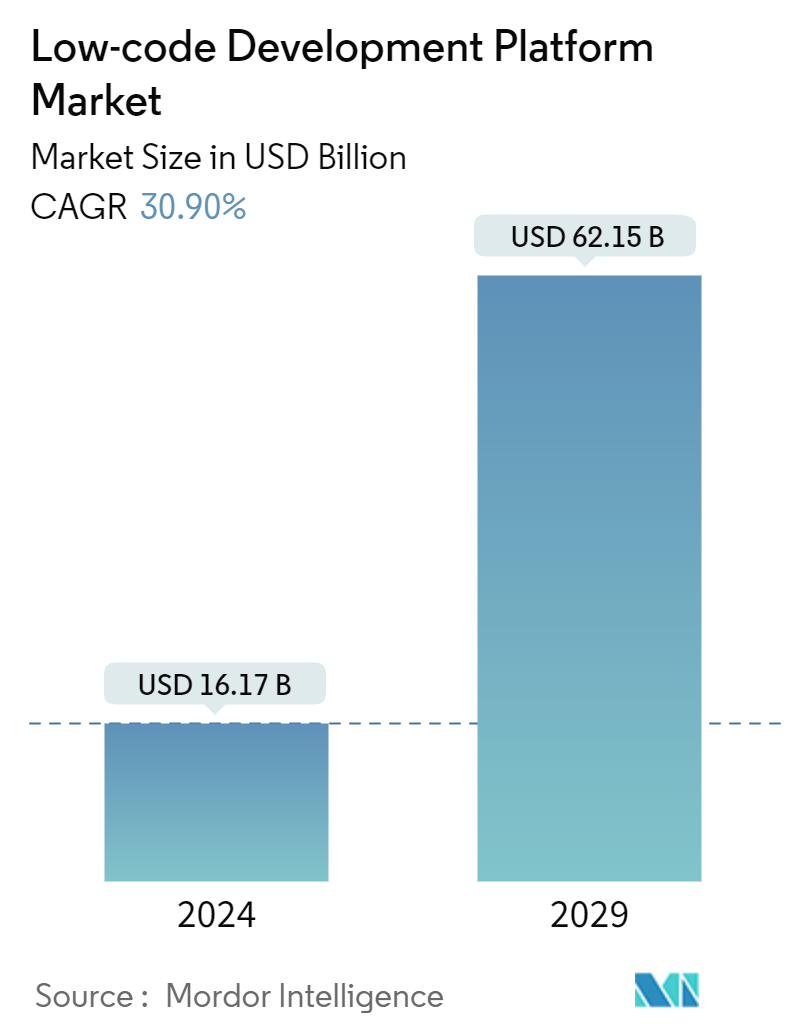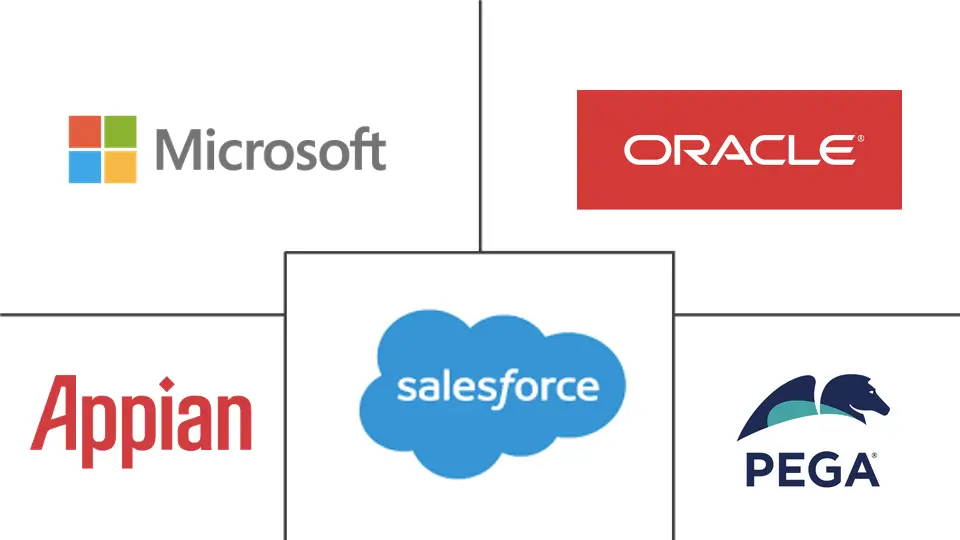Market Size of Low-code Development Platform Industry

| Study Period | 2019 - 2029 |
| Market Size (2024) | USD 16.17 Billion |
| Market Size (2029) | USD 62.15 Billion |
| CAGR (2024 - 2029) | 30.90 % |
| Fastest Growing Market | Asia-Pacific |
| Largest Market | North America |
| Market Concentration | Medium |
Major Players
*Disclaimer: Major Players sorted in no particular order |
Low-code Development Platform Market Analysis
The Low-code Development Platform Market size is estimated at USD 16.17 billion in 2024, and is expected to reach USD 62.15 billion by 2029, growing at a CAGR of 30.90% during the forecast period (2024-2029).
Businesses are increasingly embracing low-code solutions as they pivot toward digital modernization. This shift aims to enhance user experiences, streamline processes, and fortify essential systems. The appeal of low-code platforms lies in their cost-effectiveness. The advantage of low code is its drag-and-drop interface, which saves time. In low code, every single process is shown visually with the help of a graphical interface that makes everything easier to understand. It is easier for developers to create their applications.
Low-code solutions empower organizations to create functional solutions and integrations swiftly, outpacing the pace and flexibility of traditional on-premise developments. Previously, integration demanded laborious IT efforts, necessitating custom development on both ends. As more organizations adopt a "buy versus build" approach to software development, they turn to self-service and other solutions with unique functionality to increase speed and efficiency. In addition, the vendor-developed components of low-code tools also offer a better user experience.
Artificial intelligence (AI) is seeing broad adoption in global industries. However, hurdles like talent shortages and high implementation costs hinder its full integration. To address this, low-code AI is rising as a pivotal concept, especially in application and software development. Given its versatility and advantages, many enterprises are channeling investments into this platform.
By harnessing low-code AI, enterprises gain numerous benefits, such as bolstered data analytics, streamlined user experiences, cost savings, and faster development cycles. This heightened utility is fueling a surge in the adoption of low-code AI, poised to propel market growth. For instance, in October 2023, Rasa unveiled a conversational platform deeply rooted in generative AI. This move simplified the AI assistant creation process and prioritized user-friendliness due to its intuitive user interface.
Companies in diverse industries increasingly embrace low-code development platforms to accelerate their software development timelines. For instance, Siemens utilizes Mendix, a significant low-code platform, for developing industrial IoT applications. Also, in January 2024, Oracle announced that the low-code platform continues to enhance its capabilities. The recent Oracle APEX versions 23.1 and 22.1 introduced many potent and practical features.
Furthermore, businesses increasingly turn to low-code solutions to accelerate project development at a reduced cost. Additionally, given their constraints in resources and funds, small and medium-sized enterprises are increasingly gravitating toward instant application development platforms.
For instance, in August 2023, Workato, in collaboration with IMDA and tech partners SGTech, HReasily, and Stone Forest, joined forces to assist 1,500 SMEs in Singapore. Their goal is to streamline and automate workflows. Leveraging Workato's no-code, low-code platform, these SMEs were poised to realize their digital capabilities fully.
Moreover, rising costs due to inflation can lead to increased prices for low-code platform subscriptions and associated services, making them less attractive to cost-conscious organizations. Also, macroeconomic factors affecting global supply chains can lead to delays in hardware procurement and deployment, which can, in turn, slow down the adoption of low-code platforms.
Low-code Development Platform Industry Segmentation
A low-code development platform (LCDP) offers a coding environment that enables developers with varying expertise to build applications. It uses a dynamic graphical user interface and configuration with model-driven logic instead of conventional hand-coded computer programming. For specific situations, these platforms may require extensive coding.
The low-code development platform market is segmented by application type (web-based, mobile-based, and desktop and server-based), deployment type (on-premise and cloud), organization size (small and medium enterprises and large enterprises), end-user verticals (BFSI, retail and e-commerce, information technology, energy and utilities, manufacturing, healthcare, government, and defense, and other end-user verticals), and geography (North America, Europe, Asia-Pacific, Latin America, and the Middle East and Africa). The market sizes and forecasts are provided in terms of value (USD) for all the above segments.
| By Application Type | |
| Web-based | |
| Mobile-based | |
| Desktop- and Server-based |
| By Deployment Type | |
| On-premise | |
| Cloud |
| By Organization Size | |
| Small and Medium Enterprises | |
| Large Enterprises |
| By End-user Vertical | |
| BFSI | |
| Retail and E-commerce | |
| Government and Defense | |
| Information Technology | |
| Energy and Utilities | |
| Manufacturing | |
| Healthcare | |
| Other End-user Verticals |
| By Geography | |
| North America | |
| Europe | |
| Asia-Pacific | |
| Latin America | |
| Middle East and Africa |
Low-code Development Platform Market Size Summary
The low-code development platform market is experiencing rapid expansion, driven by the increasing need for digital transformation across various industries. These platforms offer a cost-effective solution for businesses aiming to enhance user experiences, automate processes, and upgrade critical systems. The drag-and-drop interface of low-code platforms simplifies the application development process, allowing for faster delivery and greater agility compared to traditional development methods. This has led to a surge in demand, particularly during the COVID-19 pandemic, as companies sought to quickly adapt to remote operations and meet the growing demand for digital solutions. The IT sector, in particular, has shown significant interest in low-code platforms due to their ability to streamline application development and improve resource utilization.
The market is characterized by moderate fragmentation, with numerous players and significant governance challenges. Major companies are engaging in strategic mergers and acquisitions, while smaller vendors focus on product innovation to capture market share. The Asia-Pacific region is expected to see substantial growth, driven by the adoption of mobile applications and government initiatives promoting digital services. Recent developments in the market include the launch of new low-code solutions and the integration of artificial intelligence to enhance platform capabilities. These advancements are poised to further accelerate the adoption of low-code development platforms, offering businesses a competitive edge in the rapidly evolving digital landscape.
Low-code Development Platform Market Size - Table of Contents
-
1. MARKET INSIGHTS
-
1.1 Market Overview
-
1.2 Industry Attractiveness - Porter's Five Forces Analysis
-
1.2.1 Bargaining Power of Suppliers
-
1.2.2 Bargaining Power of Consumers
-
1.2.3 Threat of New Entrants
-
1.2.4 Threat of Substitute Products
-
1.2.5 Intensity of Competitive Rivalry
-
-
1.3 Impact of Key Macroeconomic Trends on the Market
-
-
2. MARKET SEGMENTATION
-
2.1 By Application Type
-
2.1.1 Web-based
-
2.1.2 Mobile-based
-
2.1.3 Desktop- and Server-based
-
-
2.2 By Deployment Type
-
2.2.1 On-premise
-
2.2.2 Cloud
-
-
2.3 By Organization Size
-
2.3.1 Small and Medium Enterprises
-
2.3.2 Large Enterprises
-
-
2.4 By End-user Vertical
-
2.4.1 BFSI
-
2.4.2 Retail and E-commerce
-
2.4.3 Government and Defense
-
2.4.4 Information Technology
-
2.4.5 Energy and Utilities
-
2.4.6 Manufacturing
-
2.4.7 Healthcare
-
2.4.8 Other End-user Verticals
-
-
2.5 By Geography
-
2.5.1 North America
-
2.5.2 Europe
-
2.5.3 Asia-Pacific
-
2.5.4 Latin America
-
2.5.5 Middle East and Africa
-
-
Low-code Development Platform Market Size FAQs
How big is the Low-code Development Platform Market?
The Low-code Development Platform Market size is expected to reach USD 16.17 billion in 2024 and grow at a CAGR of 30.90% to reach USD 62.15 billion by 2029.
What is the current Low-code Development Platform Market size?
In 2024, the Low-code Development Platform Market size is expected to reach USD 16.17 billion.

